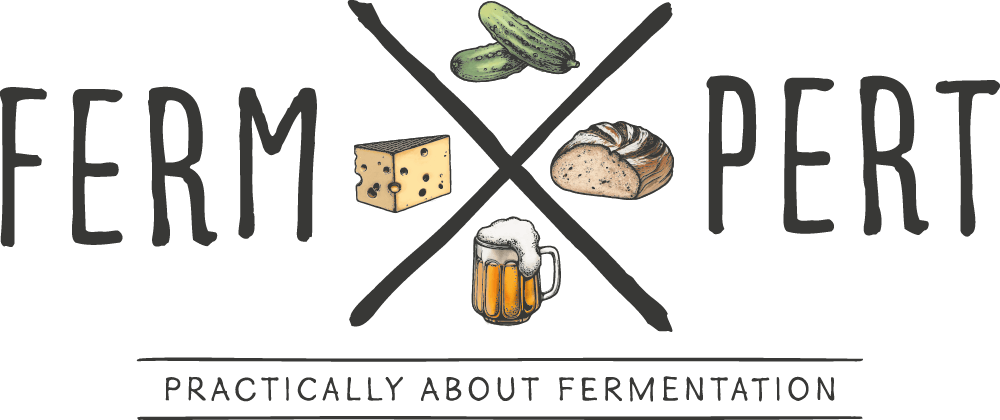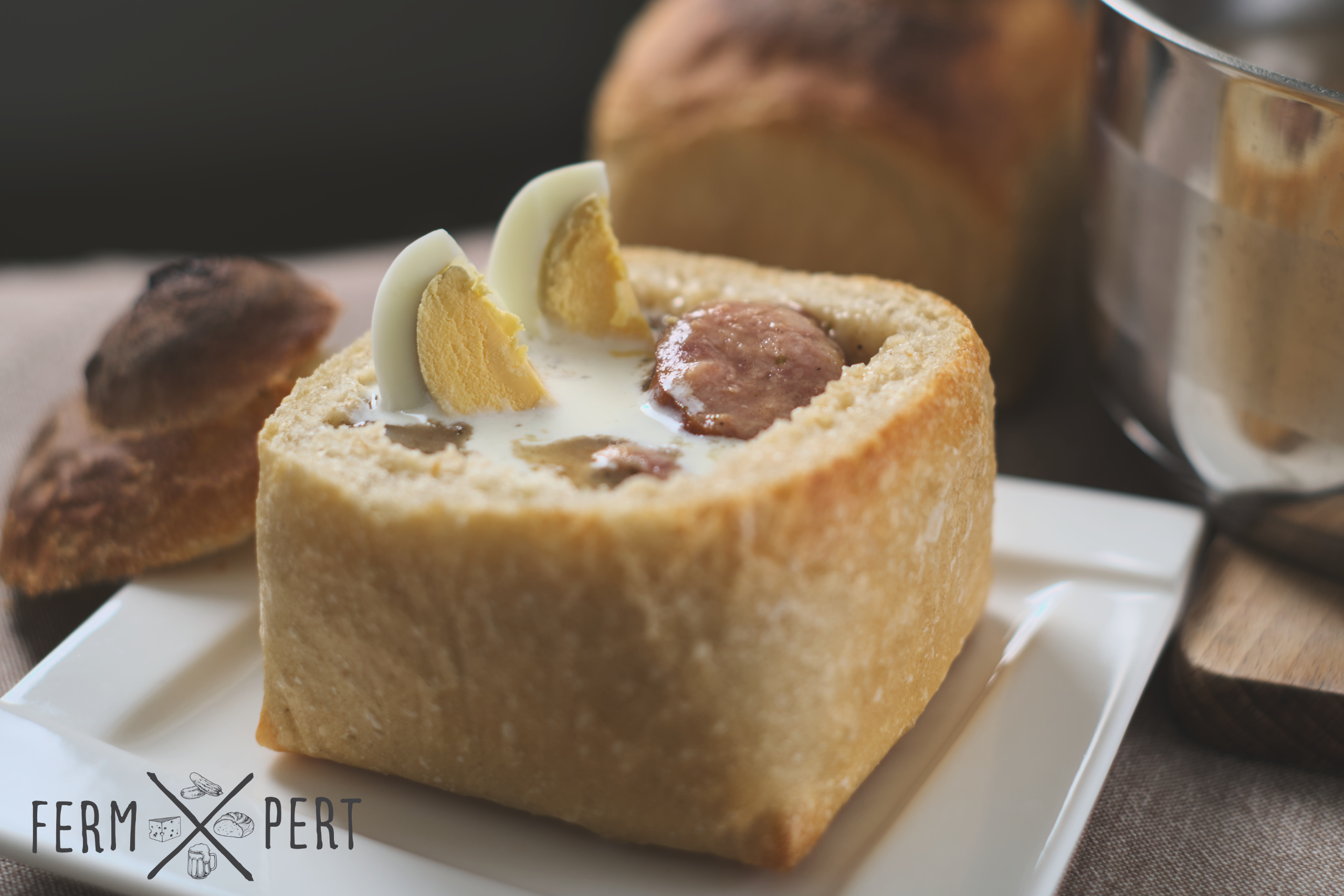This had to happen sooner or later. Żurek, also known as żur (pronounced like the French word jour) is one of Poland’s most famous soups, and a typical Easter dish too. I think it’s a good moment to post a recipe.
Recipe
The ingredient amounts given are enough to prepare 1.5 L of żurek, enough for four portions. Some ingredients are optional and the ratios can be tweaked to match individual needs.
Ingredients – Rye Starter
- 600 ml water
- 75 g wholemeal rye flour
- 10 allspice berries
- 4 bay leaves
- 3 garlic cloves
Ingredients – Soup
- 750 ml broth
- fully fermented rye starter
- 1 medium-sized onion
- 2 tsp dried marjoram
- salt, pepper to taste
Additional ingredients which technically could be omitted:
- 1 kiełbasa
- 1 Polish white sausage (kiełbasa biała)
- 100 g smoked bacon
- 2 large potatoes
- 4 hard-boiled eggs
- 30% fat sweet cream
Method
Prepare the starter four days before the soup. Peel the garlic and optionally make cuts in the cloves so that they release more aroma and flavour. Mix all the starter ingredients in a jar and leave to ferment, covered, at room temperature. Stir occasionally.
Peel and dice the potatoes. Slice or dice both sausage types. Dice the bacon. Peel and chop the onion.
Pour the broth into a pot, add potatoes and the sausage. Season with salt and pepper, boil. Brown the bacon and fry the onion until soft and translucent, add both to the soup. When the potatoes are cooked through, add the rye starter, straining out the garlic, allspice and bay leaves. Keep boiling, stirring constantly, until the soup thickens. Add marjoram and adjust for salt and pepper to taste. Serve with a quartered hard-boiled egg and a drizzle of cream.
Video Transcription
Among typical Easter foods in Poland, żur or żurek is probably one of, if not the first to be mentioned. I think the time is right to prepare it. The full recipe can be found on the blog.
The preparation is divided into two steps. The first one is the preparation of zakwas, a liquid rye starter. I’ll need water, wholemeal rye flour, allspice berries, bay leaves and some garlic. I peel the garlic cloves first. I like to give them a few slices, but not all the way through so that they have more surface area but stay in one piece. Into a jar they go. I add the allspice and bay leaves. Next is the flour. Finally, I pour water over the ingredients and give everything a mix.
The starter will ferment on the counter for four days. Occasionally, I’ll give it a mix so that no mould develops on the surface. The enzyme present in the flour, amylase, slowly breaks starch down into simpler carbohydrates, among them maltose. Bacteria and wild yeasts are capable of hydrolysing the maltose into glucose. The yeasts will turn some of it into ethanol. The bacteria will transform it into lactic acid.
After four days it’s time to prepare the soup. I’m going all in with the optional ingredients. Smoked bacon, Polish white sausage, kiełbasa, onion and potatoes. I peel and finely chop an onion first. My eyes are in agony right now. The onions, when cut, release sulphenic acid and alliinase, which then converts the acid into a volatile irritant, syn-propanethial S-oxide. In contact with water on my eyeballs, it is hydrolysed to sulphuric acid, which is what causes the burning sensation. The tears are the eyes’ attempt to flush the acid out. I dice the bacon. This is technically an optional ingredient but I like the smoky note it adds. I slice both sausages. Again, technically optional, but they make the soup hearty and filling. The white sausage can be difficult to find outside of Poland and is not replaceable by a somewhat similar German Weißwurst. A Polish deli might sell it. Still, żurek tastes great without it as well. I peel and dice the potatoes.
The pot is on the stove and I start by pouring broth in. Mine is chicken broth but other types work great too. Potatoes go in. I want them to be fully cooked by the time I add my rye starter. The reason is that the starter is sour. An acidic environment inhibits the heat-induced breakdown of pectins, which results in cooked but tough potatoes. I find this desired in other soups like the sour gherkin soup, but not a thick and creamy one like żurek. I also place the sausage in the pot too. In the case of kiełbasa, it doesn’t make a difference, but the white sausage cannot be consumed raw and needs to be cooked. I season the soup with salt and pepper.
While the potatoes and the white sausage are boiling, I deal with the bacon and onion. I add a little oil to a frying pan. Lard would probably have been even better. More fat will come out of the bacon. When the bacon is browned, I add the onions and fry them until they’re soft and translucent. Once I’m done, I add them to the soup.
The potatoes are cooked very well. It’s time to add the rye starter. I strain out the garlic, allspice and bay leaves. I also season the soup with a good amount of dried marjoram. As I mix, I can see the soup thicken due to the starch from the rye flour gelatinising under the influence of heat. After a minute or two, it can be served.
I adjust the seasoning. I’ll serve the soup inside a hollowed-out loaf of bread. This is probably too fancy for everyday meals, but it’s sure to wow the guests on Easter. The soup is usually served with a quartered hard-boiled egg. My loaf can only contain a small serving so I’ll use half an egg and save the other half for seconds. Finally, a drizzle of cream. I’m using 30% fat sweet cream as it doesn’t curdle in the hot soup. Using sour cream is OK as well, though it likes to curdle if it’s not tempered with small amounts of soup first. This is how I’d serve my żurek. Alright, time to have a taste. It’s thick, hearty and complex. The starter obviously brought a lot of sourness in, but there’s a lot of umami too. The marjoram, the garlic, it’s all in there. Absolutely delicious.

